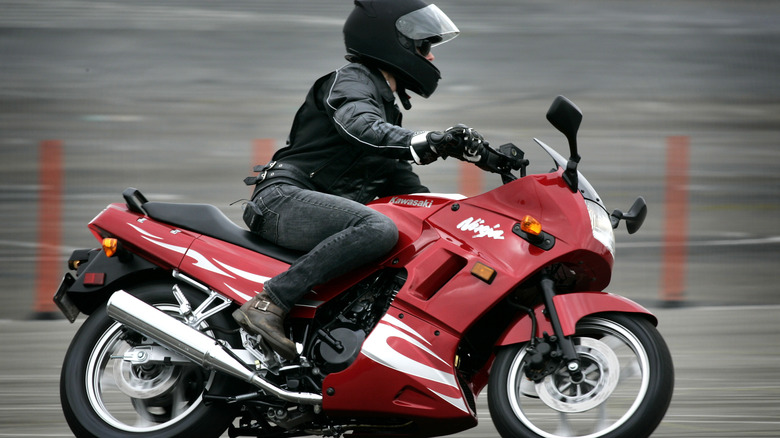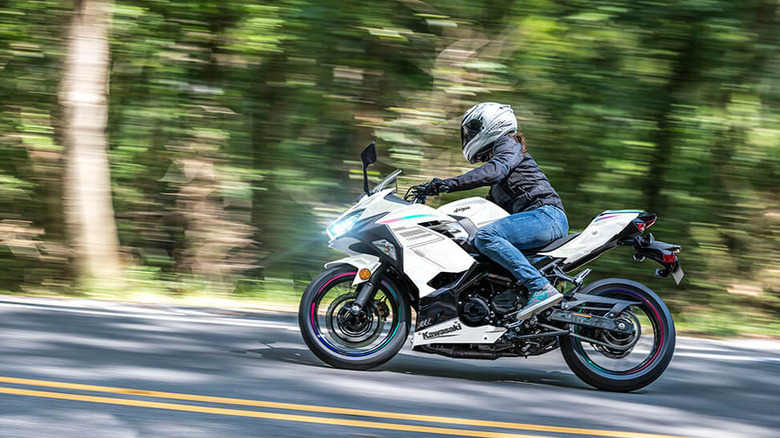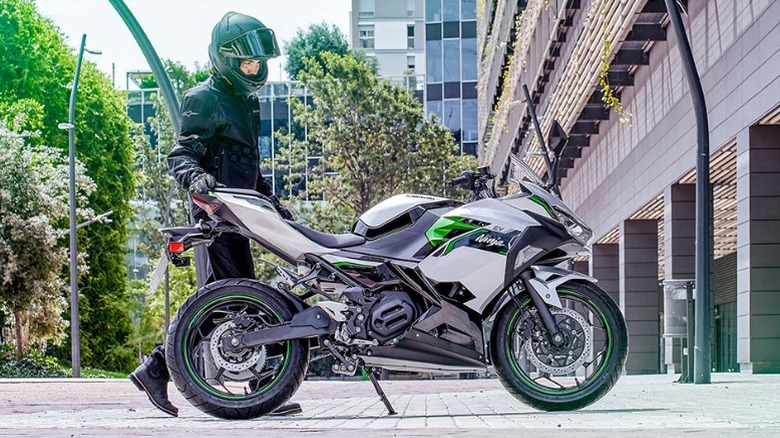Which Kawasaki Motorcycle Replaced The Ninja 250R?
The Ninja 250R was one of Kawasaki's most popular entry-level motorcycles for a long time. This bike was first launched in 1986 and was the cornerstone of the Ninja lineup for more than three decades. There was a brief period in 2012 when the bike was regionally replaced with the 300 model, but it quickly reappeared the following year.
The approachable engine size and price point made it a great option for new riders, and its smaller physical dimensions made it a good choice for shorter riders who might have struggled with larger bikes. Add in some decent gas economy, affordable maintenance, a top speed close to 100 mph making it viable for the highway, and a solid reputation for reliability, and it's easy to see why you would find so many riders winding through back roads on one of these on any given summer weekend.
There aren't any new versions of the 250R on lots anymore. After more than 30 years of production, Kawasaki removed the 250R from their product line and it hasn't shown any signs that there will be another one on the horizon. What's more, it doesn't really seem like the company is trying to replace it. There is no 300cc model on the docket either, leaving the smaller-engine side of the Ninja line completely vacant. That said, there are a few candidates that riders who would have been interested in the 250R can look at.
The Ninja 400 is now the smallest gas-powered Ninja
With the 250R retired and no new Ninja 300cc model making its appearance, the Ninja 400 is now the smallest gas engine sport bike that Kawasaki makes. It's powered by a 399cc, 4-stroke, parallel twin, DOHC, liquid-cooled engine. It has a 70mm bore, a 51.8mm stroke, and a 11.5:1 compression ratio. All of this adds up to a bike with a top speed of 116.7 mph that offers a pretty big step up in power from the 248cc Ninja 250R, so it doesn't quite fill that gap left by its smaller sibling which many riders chose specifically for its unintimidating engine. Still, the Ninja 400 is a good size for many beginners.
There are a lot of riders who prefer a 400cc bike for when they're learning. These motorcycles are still much smaller than the majority of sport bike models while having plenty of highway power. They can also bear a lot more weight without getting bogged down, which is a huge selling point for heavier riders.
The Ninja 400 has a 30.9-inch seat height, which makes it approachable for shorter riders as well. With a starting MSRP of $5,299, it's definitely on the more affordable side. All of this together offers a great entry point for riders who are looking to get a small, affordable motorcycle. But there are those for whom the 400 can still be a little too large or intimidating. Fortunately, Kawasaki has a bike for them too.
The Z125 Pro is even smaller
The Kawasaki Z125 Pro is a miniature motorcycle that is similar in both design and performance to the Honda Grom, so it's more of a street bike than a sport bike. It's powered by a 125cc, 4-stroke, 1-cylinder, SOHC, 2-valve, air-cooled engine, which is even smaller and less powerful than the one found in the 250R. This gives it a top speed of 65 mph and provides an alternative for those who are learning to ride and find the Ninja 400 too big and powerful.
Most of its dimensions are much smaller than the Ninja 250R and the Ninja 400. It's only 66.9 inches long and 29.5 inches wide. Funnily enough, it has a slightly taller seat height, placing the rider 31.7 inches off the ground. Even so, many shorter riders have found the Z125 Pro to be reasonably comfortable. It's also one of the cheapest bikes that Kawasaki makes, starting at just $3,649.
There are a lot of ways that the Z125 Pro can't compare to the 250R, but it's also easy to see why Kawasaki may have felt that having both the Z125 and the Ninja 400 available would give options that would cater to many of the riders who were previously interested in the 250R.
The e-1 is the least powerful Ninja
It's true that the Ninja 400 is the smallest Ninja gas motorcycle in Kawasaki's current lineup, but the manufacturer does make one bike with a little less power if you're looking for something that doesn't have too much juice off the starting line. The Ninja e-1 ABS is fully electric, running on an air-cooled, interior permanent magnet synchronous motor. This makes it difficult to compare to the size of a gas engine, but TopSpeed claimed that it's performance is comparable to that of a 125cc motorcycle.
It has two power modes, each with their own respective top speed. Eco mode preserves energy, but tops out at 40 mph, while Road mode can give the bike a boost at the cost of battery power and get it up to 55 mph. It has a rated power of 5 kW, a max power of 9 kW, and can get up to 29.7 lb-ft of torque at 500 rpm. So, like the Z125 Pro, this once again represents a step down in power and performance from the Ninja 250R. That said, the e-1 is much closer to the 250R's sporty styling.
The e-1 is 78 inches long, 27 inches wide, and has a 30.9-inch seat height. This makes it yet another bike that is friendly to smaller riders. It has a $7,899 starting price, which makes it less approachable to budget-minded buyers than the other bikes on this list, but it's still on the cheaper side of Kawasaki's overall lineup.



